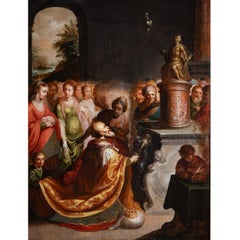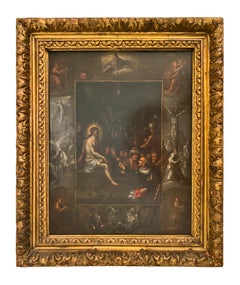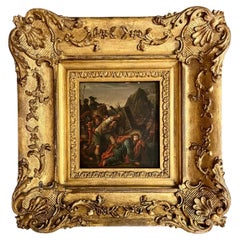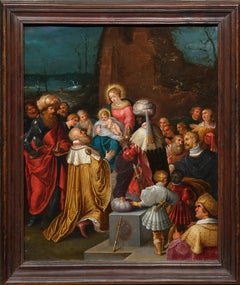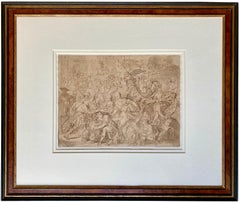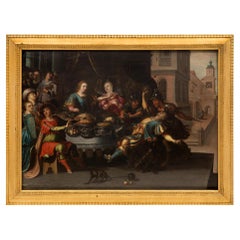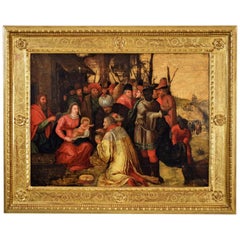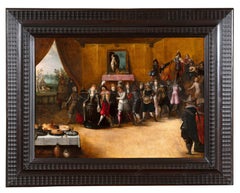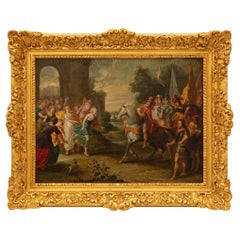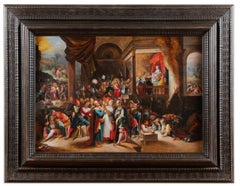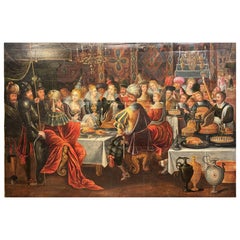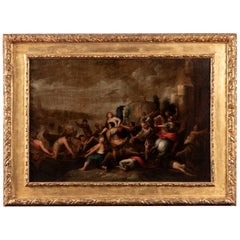Frans Francken
The Idolatry of Solomon AFTER Frans Francken the Younger (Flemish, 1581–1642)
By Frans Francken II
Located in Greding, DE
This painting depicts "The Idolatry of Solomon," inspired by Frans Francken the Younger, a Flemish
Category
Early 17th Century Baroque Figurative Paintings
Materials
Oil, Wood
$8,357
H 32.68 in W 26.78 in D 1.58 in
Mocking of Christ, by Frans Francken (II) and possibly Ambrosius Francken (II)
By Frans Francken II
Located in New York, NY
Museum Catharijneconvent, Utrecht (Museum Catharijneconvent) 2002, p. 196, pict., as Frans Francken II
Category
17th Century Mannerist Figurative Paintings
Materials
Copper
$5,200 Sale Price
56% Off
H 14.18 in W 11.42 in D 0.4 in
17th Century Flemish Old Master Painting Circle of Frans Francken.
By Frans Franken the Younger
Located in Vero Beach, FL
17th Century Flemish Old Master Painting Circle of Frans Francken
Rare 17th century Flemish School
Category
Antique 17th Century Dutch Renaissance Paintings
Materials
Wood, Giltwood
$4,750
H 1,575 in W 15.5 in D 3.25 in
The Adoration of the Magi, an early painting by Frans Francken II (1581 - 1682)
By Frans Francken II
Located in PARIS, FR
nature of this painting by Frans Francken the Younger in a certificate issued on December 9, 2024.
In
Category
1610s Old Masters Figurative Paintings
Materials
Copper
$74,021
H 16.13 in W 13.88 in
'The Departure of the Israelites from Egypt' by Frans Francken the Younger
Located in Knokke, BE
Frans Francken the Younger
1581 - Antwerp - 1642
Flemish Painter
'The Departure of the Israelites
Category
Early 17th Century Baroque Interior Paintings
Materials
Paper, Pen
$20,057
H 21.66 in W 25.79 in D 1.58 in
Dutch 17th Century Oil on Wood Painting in the Manner of Frans Francken
Located in West Palm Beach, FL
A sensational Dutch 17th century Oil on Wood painting in the manner of Frans Francken. The painting
Category
Antique 17th Century Dutch Paintings
Materials
Canvas, Giltwood
$69,800
H 25 in W 32.75 in D 1.5 in
"Adoration of the Magi"
Located in Edinburgh, GB
Attributed to Frans Francken II (1581-1642) – "Adoration of the Magi"
Medium: Oil on canvas
Category
17th Century Realist Figurative Paintings
Materials
Oil, Canvas
Frans Franken III 16th Century Oil on Wood, Adoration of the Magi, Painting
By Frans Franken the Younger
Located in IT
work is attributable to the workshop of the Flemish painter Frans Francken III, belonging to a prolific
Category
Antique 16th Century Belgian Renaissance Paintings
Materials
Paint
$33,429
H 28.75 in W 35.83 in D 1.97 in
Attributed à H. Francken II, 17th c. Anwerp - The prodigal son among courtesans
Located in PARIS, FR
extant pictorial work is also one of the characteristics of the Francken family, among them Frans
Category
Early 17th Century Old Masters Interior Paintings
Materials
Oak, Oil
$27,459
H 30.7 in W 39.37 in
Flemish Late 17th Century/Early 18th Century Oil on Canvas Painting
Located in West Palm Beach, FL
possibly by Frans Francken III. The beautiful and wonderfully executed painting depicts the story of
Category
Antique 17th Century Dutch Paintings
Materials
Canvas, Giltwood
$68,900
H 30.25 in W 37.5 in D 3.25 in
Hieronymus FRANCKEN III - The Denial of Saint Peter, 17th c. Antwerp school
Located in PARIS, FR
works including Frans Francken der Jüngere, 1581-1642, editions Freren, 1989.
Ursula Harting was also
Category
Mid-17th Century Old Masters Figurative Paintings
Materials
Oil, Wood Panel
$40,592
H 32.28 in W 42.52 in
The Feast of Balthazar, Frans FRANKEN II and workshop, 17th c.
By Frans Francken II
Located in PARIS, FR
Large oil on oak panel (105 x 72 cm), portraying ‘The Feast of Balthazar’.
Attributed to Frans
Category
Antique 17th Century Dutch Other Paintings
Materials
Wood
$15,520
H 28.35 in W 41.34 in D 1.97 in
Painting with a Healing Scene 17th Century
Located in Milan, IT
Olio su rame. Scuola fiamminga del XVII secolo.
Il dipinto, attribuito da tradizione orale a Frans
Category
17th Century Other Art Style Figurative Paintings
Materials
Oil
Frame. Ebonized wood, metal. Dutch School, 17th century.
Located in Madrid, ES
the frame for Philippe de Marlier and Frans Francken's "Vase of Tulips" in the Bilbao Fine Arts Museum
Category
Antique 17th Century European Baroque Picture Frames
Materials
Other
17th century, Flemish School, Adoration of the Magi
Located in Milan, IT
il dipinto ai coevi esempi realizzati da artisti del calibro dell’eclettico Frans Francken il Giovane
Category
Antique 18th Century and Earlier Dutch Other Paintings
Materials
Copper
Circle of Hans Jordaens III (ca 1595 - ca 1643), Christ ascending to Calvary
Located in Milan, IT
di collezioni d’arte nello stile di Frans Francken II. Collaborò, inoltre, con Abraham Govaerts
Category
18th Century and Earlier Other Art Style Figurative Paintings
Materials
Copper
$7,163
H 7.88 in W 10.24 in
The Musical Contest between Apollo and Marsyas, signed P. Sion, Antwerp 17th c.
Located in PARIS, FR
is very close to the late Mannerism of Frans Francken and his workshop, with which his works are
Category
17th Century Old Masters Figurative Paintings
Materials
Oak, Oil, Wood Panel
$13,729
H 31.5 in W 28.35 in
The Rape of Europa, signed Peter Sion (1624-1695), Antwerp, 17th century
Located in PARIS, FR
is very close to the late Mannerism of Frans Francken and his workshop, with which his works are
Category
17th Century Old Masters Figurative Paintings
Materials
Oak, Oil, Wood Panel
$13,729
H 31.5 in W 28.35 in
Banquet Attrib to Van Den Hoecke Religious Oil on Table Old Master 17th Century
By Gaspar van den Hoecke (Antwerp, 1585 - 1648)
Located in Riva del Garda, IT
cm.
framed 72 x 90 cm.
Note: The painting probably dates from an original by Frans II Francken (1581
Category
17th Century Old Masters Paintings
Materials
Oil
$15,520 Sale Price
20% Off
H 28.35 in W 35.44 in
Ascension day in Venice by Louis de Caullery (1582-1621) 17th c. Flemish school
Located in PARIS, FR
have aptly been compared to the work of Frans Francken and other mannerist masters. Small-scale figures
Category
Early 17th Century Old Masters Landscape Paintings
Materials
Oak, Oil
$24,474
H 20.87 in W 31.1 in
Adoration of the Shepherds by Gillis Mostaert (1534 - 1598) Flemish Renaissance
Located in Knokke, BE
like Frans Francken the Younger.
Mostaert’s talents were sought after by fellow artists for his skill
Category
16th Century Renaissance Interior Paintings
Materials
Oil, Panel
$46,561
H 21.26 in W 24.41 in D 2.37 in
17th century ebonized Antwerp cabinet with painted panels, circle 1630
Located in PARIS, FR
example, we find a similar cabinet in a painting by Frans Francken's workshop "Achilles among the
Category
Antique 17th Century Belgian Baroque Cabinets
Materials
Wood
$77,603
H 33.86 in W 40.15 in D 18.5 in
Gortzius Geldorp, Portrait Of A Member Of The Sani Family, 16th-Century
By Gortzius Geldorp
Located in Cheltenham, GB
, Frans Francken I (1542-1616) and Frans Pourbus the Elder (1545-1581). Pourbus was a master of highly
Category
16th Century Baroque Portrait Paintings
Materials
Canvas, Oil
$18,256
H 46 in W 37 in D 3 in
Recent Sales
Helen's Kidnapping, Attributed to Frans Francken the Younger, 17th Century
By Frans Francken II
Located in Saint Ouen, FR
Helen's Kidnapping
Attributed to Frans Francken the Younger, (1581-1642).
Illegible "signature
Category
Antique Early 17th Century Dutch Baroque Paintings
Materials
Canvas
H 45.87 in W 71.86 in D 3.94 in
Pilgrims at Saint Anthony’s
By Frans Francken II
Located in Seattle, WA
x 13.4 in.)
Frans Francken II (circle)
Flemish, Antwerp 1581 ― 1642 Antwerp
Provenance
Category
1620s Baroque Figurative Paintings
Materials
Oil, Panel
Flemish painting circle of David Teniers
By David Teniers
Located in Salò, IT
galleria, inizialmente vicine allo stile di Frans Francken II, poi a quello di Adriaen Brouwer.
Teniers
Category
Antique 17th Century Dutch Paintings
Materials
Canvas
Vos beautez sont les feus et la troupe fatale qui rend amour vainqeur [...].
By Michel Lasne
Located in Zeeland, Noord-Brabant
after Frans Francken.
Michel Lasne / l'Asne (ca. 1590-1667) was a French designer, etcher and engraver
Category
17th Century Figurative Prints
Materials
Engraving
Maria, Jesus Christ and Saint John in a Garland of Flowers
By Gaspar van den Hoecke (Antwerp, 1585 - 1648)
Located in Zürich, CH
Flemish Baroque painter of small devotional cabinet pieces in the manner of Frans Francken II. His sons
Category
17th Century Paintings
Materials
Oil, Wood Panel
Parable Of The Rich Man And Lazarus
Located in Zürich, CH
were usually executed by other painters, mainly by Frans II Francken, Esaias van de Velde, Cornelis van
Category
17th Century Paintings
Materials
Oil, Panel
Madonna and Child in a garland of flowers - Studio of Frans Francken II, 17th c.
By Frans Francken II
Located in PARIS, FR
Virgin and Child in a Garland of Flowers
Studio of Frans Francken II (1581-1642)
17th century
Category
1620s Old Masters Figurative Paintings
Materials
Oil, Wood Panel
H 25.59 in W 21.26 in
17th Century Nativity Oil on Copper Attributed Frans Francken Le Jeune Painting
Located in Paris, FR
Flemish school, attributed has.
Frans Francken the young, on 1581-1642, paint on copper, in a
Category
Antique 17th Century Belgian Louis XIV Paintings
H 11.42 in W 0.4 in D 14.18 in
17th c. Flemish school - Collector's cabinet - Workshop of F. Francken II
By Frans Francken II
Located in PARIS, FR
Iconoclastic donkey bursting into collector's cabinet, workshop of Frans Francken the Younger
Our
Category
Early 17th Century Old Masters Interior Paintings
Materials
Oil, Wood Panel
Holy Family with Saints - Flemish, Antwerp, 17th century
By Frans Francken II
Located in PARIS, FR
Baptist
Studio of Frans Francken II (1581-1642)
17th century Antwerp School
Oil on copper
Dimensions: h
Category
Mid-17th Century Old Masters Figurative Paintings
Materials
Copper
Painting on Alabaster: Floral garland with Annunciation, Flanders, 17th cent
Located in Firenze, IT
Flemish painting on alabaster: Floral garland with Annunciation, Circle of Frans Francken II
Category
17th Century Flemish School Figurative Paintings
Materials
Alabaster
Bowlers - Original Oil on Canvas by the School of D. Teniers Le Jeune - 1659
Located in Roma, IT
brought by Pieter Paul Rubens. He became interested in works by the group of Frans Francken II, which
Category
1650s Figurative Paintings
Materials
Oil
H 24.81 in W 49.41 in
Dutch Style Frame, Ebony, Wood, 17th Century
Located in Madrid, ES
” by Ruysdael; or with the "Tulip Vase" by Philippe de Marlier and Frans Francken from the Bilbao Fine
Category
Antique 17th Century European Baroque Picture Frames
Materials
Other
Dutch style frame. Ebonyzed wood. 17th century.
Located in Madrid, ES
Marlier and Frans Francken from the Bilbao Fine Arts Museum. ·
Size: 67x5x64,5 / int: 45,5x54 cms
Category
Antique 17th Century European Baroque Picture Frames
Materials
Metal
Dutch Style Frame, Ebony, Wood, 17th Century
Located in Madrid, ES
the "Tulip Vase" by Philippe de Marlier and Frans Francken from the Bilbao Fine Arts Museum.
Weight
Category
Antique 17th Century European Baroque Picture Frames
Materials
Other
Dutch style frame. Ebonized wood. 17th century.
Located in Madrid, ES
de Marlier and Frans Francken from the Bilbao Fine Arts Museum. ·
Size: 67x5x74,5 / int: 45,5x54 cm
Category
Antique 17th Century European Baroque Picture Frames
Materials
Other
Frame, Ebonized Wood, Metal, Holland, 17th Century
Located in Madrid, ES
Philippe de Marlier and Frans Francken of the Bilbao Fine Arts Museum (flamenco, curly ebonized wood with
Category
Antique 17th Century Dutch Baroque Picture Frames
Materials
Other
Adoration of the Magi, School of Frans I Francken
Located in PARIS, FR
The story of the Magi comes from the Gospel of Matthew, which indicates that the Magi from the East, having followed a star, came to Bethlehem to adore the newborn King of the Jews, ...
Category
Antique 16th Century Dutch Renaissance Paintings
Materials
Canvas
The Adoration of the Magi", school of Frans I FRANCKEN (1542-1616)
Located in PARIS, FR
The story of the Magi comes from the Gospel of Matthew, which indicates that the Magi from the East, having followed a star, came to Bethlehem to adore the newborn King of the Jews, ...
Category
Antique 17th Century Dutch Louis XIII Paintings
Materials
Canvas
The Mocking of Christ
By Frans Francken II
Located in Marlow, Buckinghamshire
Description:
The Mocking of Christ surrounded by four vignettes depicting The Crucifixion (right side) The Resurrection (left side), Hades (lower centre) and God (upper centre
Prov...
Category
Early 17th Century Old Masters Figurative Paintings
Materials
Copper
Portrait of a Child
By Gortzius Geldorp
Located in Bath, Somerset
Brabant. He studied painting from circa 1570 in Antwerp with Frans Francken the elder of Herenthals and
Category
18th Century and Earlier Portrait Paintings
17th c. Flemish, Virgin and Child with angel musicians by Cornelis de Baellieur
Located in PARIS, FR
style, close to that of Frans Francken II, suggests that he worked in his studio: the same slender
Category
Early 17th Century Old Masters Figurative Paintings
Materials
Oil, Wood Panel
17th c. Flemish school - Allegory of the five senses - attributed to P. Lisaert
By Pieter Lisaert IV
Located in PARIS, FR
Frans Francken II, of whom he is a contemporary.
In an interior with refined decor, five elegantly and
Category
Early 17th Century Old Masters Interior Paintings
Materials
Oil, Wood Panel
H 13.39 in W 20.87 in
Gortzius Geldorp (Attributed To Workshop), Portrait Of A Gentleman
By Gortzius Geldorp
Located in Cheltenham, GB
and trained under two of its principal painters, Frans Francken I (1542-1616) and Frans Pourbus the
Category
1610s Old Masters Portrait Paintings
Materials
Oil, Wood Panel
The Infant Christ and John The Baptist
Located in Marlow, Buckinghamshire
backgrounds in a number of works by Von Baalen, Momper, Rottenhammer, Frans Francken and P Neefs. The
Category
Early 17th Century Old Masters Figurative Paintings
Materials
Copper
The Adulterous Woman by a Follower of Frans Francken II, Oil on Oak Panel
Located in Stockholm, SE
FRANS FRANCKEN II (FOLLOWER OF)
THE ADULTEROUS WOMAN
oil on panel
panel size: 23.62 x 32.67
Category
17th Century Old Masters Figurative Paintings
Materials
Oak, Oil, Panel
Jesus Frans Francken II Paint oil on copper Old master 17th Century Flemish Art
Located in Riva del Garda, IT
attributable to the Flemish Frans Francken II (Antwerp 1581 - 1642).
The work interprets an episode included
Category
17th Century Old Masters Paintings
Materials
Oil
Adoration Paint Oil on table 16th century Art Baroque Manierism
By Frans Francken II
Located in Riva del Garda, IT
Workshop Frans Francken II (Antwerp 1581 - 1642)
Adoration of the Magi
School of Antwerp in the
Category
17th Century Old Masters Paintings
Materials
Oil
H 24.02 in W 29.93 in
Christ Crucified Virgin Paint Oil on canvas 17th Century Flandre Religious Art
Located in Riva del Garda, IT
Flemish school, first half of the 17th century
Workshop of Frans Francken II (Antwerp 1581 - 1642
Category
17th Century Old Masters Paintings
Materials
Oil
After Franken School Crucifixion of Jesus Pannel
Located in Pasadena, CA
Frans Francken the Younger (1581, Antwerp – 6 May 1642, Antwerp was a Flemish painter and the best
Category
17th Century Flemish School Figurative Paintings
Materials
Oil
Allegory of four elements, pupil of Jan Brueghel the Younger (1601-1678)
Located in PARIS, FR
(1601-1678)
Figures by a pupil of Frans Francken II
Oil on canvas: h. 52,5 cm, w. 82 cm (11
Giltwood
Category
Mid-17th Century Old Masters Figurative Photography
Materials
Canvas, Oil
Country Fest - Etching by David Teniers - 17th Century
By David Teniers the Younger
Located in Roma, IT
Pieter Paul Rubens. He became interested in works by the group of Frans Francken II, which dealt with
Category
Late 17th Century Modern Figurative Prints
Materials
Etching
H 6.89 in W 9.06 in D 0.04 in
Dutch Style Frame, Ebonized Wood, 19th Century
Located in Madrid, ES
” by Ruysdael; or with the "Tulip Vase" by Philippe de Marlier and Frans Francken from the Bilbao Fine
Category
Antique 19th Century European Other Picture Frames
Materials
Other
Frame. Ebonized wood, metal. Dutch school, 17th century.
Located in Madrid, ES
; or with the “Vase of Tulips” by Philippe de Marlier and Frans Francken in the Bilbao Fine Arts Museum
Category
Antique 17th Century European Baroque Picture Frames
Materials
Other
Still-Life Flowers Picart 17th Century Paint Oil on canvas Old master Flemish
Located in Riva del Garda, IT
workshop of Frans Francken Il, around 1625 Picart moved to Paris, where he remained for the rest of his
Category
17th Century Old Masters Paintings
Materials
Oil
Rare reverse glass painting, Singerie, Monkeys playing cards and drinking
Located in DEVENTER, NL
by those in Antwerp such as Frans Francken the Younger, Jan Brueghel the Elder and the Younger
Category
19th Century Animal Paintings
Materials
Glass
Portrait of a Gentleman in Armour - Flemish 17th Century Old Master oil painting
By Jacob Ferdinand Voet 1
Located in London, GB
developed in Antwerp by artists such as Jan Brueghel the Elder, Hendrick van Balen, Frans Francken the
Category
17th Century Old Masters Portrait Paintings
Materials
Oil
Adoration of the Magi, , workshop of Frans Francken II , Flemish 17th century
By Frans Francken II
Located in Paris, FR
Adoration of the Magi, ,workshop of Frans Francken II , Flemish 17th century
Oil on copper
The
Category
Antique Early 17th Century French Louis XIII Paintings
Materials
Copper
H 18.51 in W 15.75 in D 1.97 in
Salome and King Herod, Francken Family Workshop, Antwerp, 17th Century
By Frans Francken II
Located in Paris, FR
mark of Antwerp workshops on the back of the panel.
19th century giltwood frame.
Francken family
Category
Antique 1630s Dutch Mannerist Paintings
Materials
Giltwood, Oak
H 22.45 in W 32.29 in D 1.97 in
Adoration of the Three Wise Men Represented as Kings, Oil on Copper, Flanders
By Frans Francken II
Located in Paris, FR
on copper, Francken family workshop, circa 1620.
Flanders,
19th century frame.
The Francken family
Category
Antique Early 17th Century Dutch Baroque Paintings
Materials
Copper
H 13.78 in W 10.83 in D 1.97 in
People Also Browsed
Fabergé Silver Service
By Fabergé
Located in New Orleans, LA
This extraordinary 128-piece service by Fabergé is a rare treasure in more ways than one. Enclosed in its original oak chest, the exquisite service remains complete and in pristine c...
Category
Antique 19th Century Russian Sterling Silver
Materials
Silver
17th Century Old Master Crucifixion of Christ
Located in Nottingham, GB
In good condition
From a private collection
Free international shipping
17th Century Old Master Crucifixion of Christ
Category
Antique 17th Century Paintings
Materials
Canvas, Paint
Saint Michael the Archangel, Sevillan school
Located in New York, NY
An engraving by Jerónimo Wierix after Marten de Vos's Saint Michael the Archangel (Iglesia de San Miguel, Córdoba) may have been a source for this painting. The composition is also c...
Category
17th Century Baroque Figurative Paintings
Materials
Canvas, Oil
Pietà Saint John De Morales Paint Oil on table 16/17th Century Old master
Located in Riva del Garda, IT
Luis de Morales, called 'El Divino' (Badajoz 1509 - 1586) workshop of
La Pietà with Saint John
Oil on panel (82 x 65 cm /In frame 109 x 92 cm)
STATE OF CONSERVATION: The panel is in ...
Category
16th Century Old Masters Paintings
Materials
Oil
$10,802 Sale Price
20% Off
H 42.92 in W 36.23 in
Rembrandt Etching Framed
By Rembrandt van Rijn
Located in New York, NY
Original Self-Portrait Etching by Rembrandt van Rijn (1606-1669)
Etching on paper
2 ⅛ x 1 ¾ inches unframed (5.4102 x 4.445 cm)
14 ⅛ x 12 ½ inches framed (35.8902 x 31.75 cm)
Descri...
Category
17th Century Old Masters Portrait Prints
Materials
Etching
17th Century Flemish Tapestry 8'5" X 6'11"
Located in Los Angeles, US
A wall hanging tapestry, simply put, is a textile specifically designed and woven to portray an artistic scene with the intent of hanging it on a wall. Antique tapestries, those that...
Category
Antique 17th Century Unknown Other Tapestries
Materials
Wool, Cotton
The Bird Concert – After Jacob Savery
By Jacob Savery I
Located in Stockholm, SE
Follower of Jacob Savery (1566-1603)
Concert of Birds
18th-century
oil on panel
no signature
unframed: 42 × 44 cm (16.5 × 17.3 in)
framed: 53 × 54 cm (20.9 × 21.3 in)
Expertise:
...
Category
18th Century Old Masters Animal Paintings
Materials
Oil, Wood Panel
Raimundo de Madrazo y Garreta Palatial Oil on Canvas Portrait Isabelle McCreery
By Raimundo de Madrazo y Garreta
Located in LA, CA
Raimundo De Madrazo y Garreta (Spanish School, 1841-1920) an exceptional and palatial oil on canvas "Portrait of Isabelle McCreery” depicting an elegant woman gracefully exiting a li...
Category
19th Century Romantic Figurative Paintings
Materials
Oil
$750,000
H 132 in W 87.5 in D 8 in
Diana and Actaeon, a Mannerist painting after Joseph Heintz the Elder
Located in PARIS, FR
This painting seduced us with its rich colors. Depicting Diana and her companions surprised by Actaeon, it was inspired by an engraving by Aegidius Sadeler II after a painting by Jos...
Category
17th Century Old Masters Nude Paintings
Materials
Oil, Wood Panel
$21,490
H 20.88 in W 26.07 in
Madonna and child with angels, circle of Joos Van Cleve, 16th c. Antwerp school
By Joos van Cleve
Located in PARIS, FR
Madonna and Child with Saint John the Baptist and angels
Circle of Joos Van Cleve (1485 – 1541)
16th century Antwerp school
Oil on oak panel
Dimensions: h. 32 cm (13 in.), w. 28.5 cm...
Category
16th Century Old Masters Figurative Paintings
Materials
Oak, Oil
$26,265
H 25.2 in W 24.02 in
An Architectural Capriccio with the Preaching of an Apostle
By Giovanni Paolo Panini
Located in New York, NY
Provenance: Santambrogio Antichità, Milan; sold, 2007 to:
Filippo Pernisa, Milan; by whom sold, 2010, to:
Private Collection, Melide, Switzerland
De Primi Fine Art, Lugano, S...
Category
18th Century Old Masters Figurative Paintings
Materials
Canvas, Oil
$85,000
H 38.75 in W 28.75 in
Macbeth and the Three Witches a Painting on Panel by Francesco Zuccarelli
By Francesco Zuccarelli
Located in PARIS, FR
This painting, created during Zuccarelli's stay in England, represents the decisive moment when Macbeth, together with Banquo, meets the three witches who announce that he will be Ki...
Category
1760s Old Masters Landscape Paintings
Materials
Oil, Wood Panel
$55,000
H 17.33 in W 22.05 in
Portrait of Lady Caroline Price
By George Romney
Located in Miami, FL
DESCRIPTION: Perhaps the best Romney in private hands. If Vogue Magazine existed in the late 18th century, this image of Lady Caroline Price would be on one of its covers. The e...
Category
1970s Old Masters Portrait Paintings
Materials
Oil, Canvas
17th Century Flemish Old Master Dancing Figures Musicians Antique Oil Painting
Located in Cirencester, Gloucestershire
Dancing Figures
Flemish School, 17th century
oil on on canvas, framed
framed: 21.5 x 28.5 inches
canvas : 16.5 x 24 inches
Provenance: private collection, France
Condition: very good...
Category
17th Century Baroque Figurative Paintings
Materials
Oil
$3,595
H 21.5 in W 28.5 in
Fine 18th Century British Oil Painting Mother & Infant Child in Adoration
Located in Cirencester, Gloucestershire
Mother & Child
British artist, late 18th century
after the painting by Sir Anthony van Dyke
oil on canvas, unframed
canvas : 20 x 18 inches
provenance: private collection, Berkshire,...
Category
18th Century Old Masters Figurative Paintings
Materials
Oil, Canvas
“Ressurrection”, Polychromed Wood, Spanish School, 16th Century
Located in Madrid, ES
The relief was probably a door of the Sagrario. The piece follows a customary decoration in the tabernacles of the Renaissance and the Baroque. Compare, for example, with the sevente...
Category
Antique 16th Century Spanish Renaissance Religious Items
Materials
Other
Get Updated with New Arrivals
Save "Frans Francken", and we’ll notify you when there are new listings in this category.
Frans Francken For Sale on 1stDibs
You are likely to find exactly the frans francken you’re looking for on 1stDibs, as there is a broad range for sale. Making the right choice when shopping for a frans francken may mean carefully reviewing examples of this item dating from different eras — you can find an early iteration of this piece from the 16th Century and a newer version made as recently as the 18th Century. When looking for the right frans francken for your space, you can search on 1stDibs by color — popular works were created in bold and neutral palettes with elements of black and brown. Artworks like these of any era or style can make for thoughtful decor in any space, but a selection from our variety of those made in oil paint, paint and panel can add an especially memorable touch.
How Much is a Frans Francken?
The average selling price for a frans francken we offer is $18,725, while they’re typically $1,858 on the low end and $69,800 for the highest priced.
More Ways To Browse
Antique Collectors Cabinet Cabinets
Antique Silver Cabinet
Collectors Display Cabinet
Urn Cabinet
London Display Case
France Son Leather
Antique Curiosity Cabinet
Antique Silver Storage Cabinet
Museum Display Case
London Display Cabinet
Antique Jewelry Cabinet
Antique End Tables With Storage
Wavy Cabinet
Jewelry Display Case
Antique Doors Belgium
Cabinet With Clock
Antique Fire Door
Fire King
